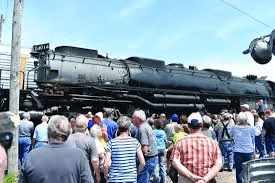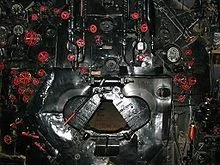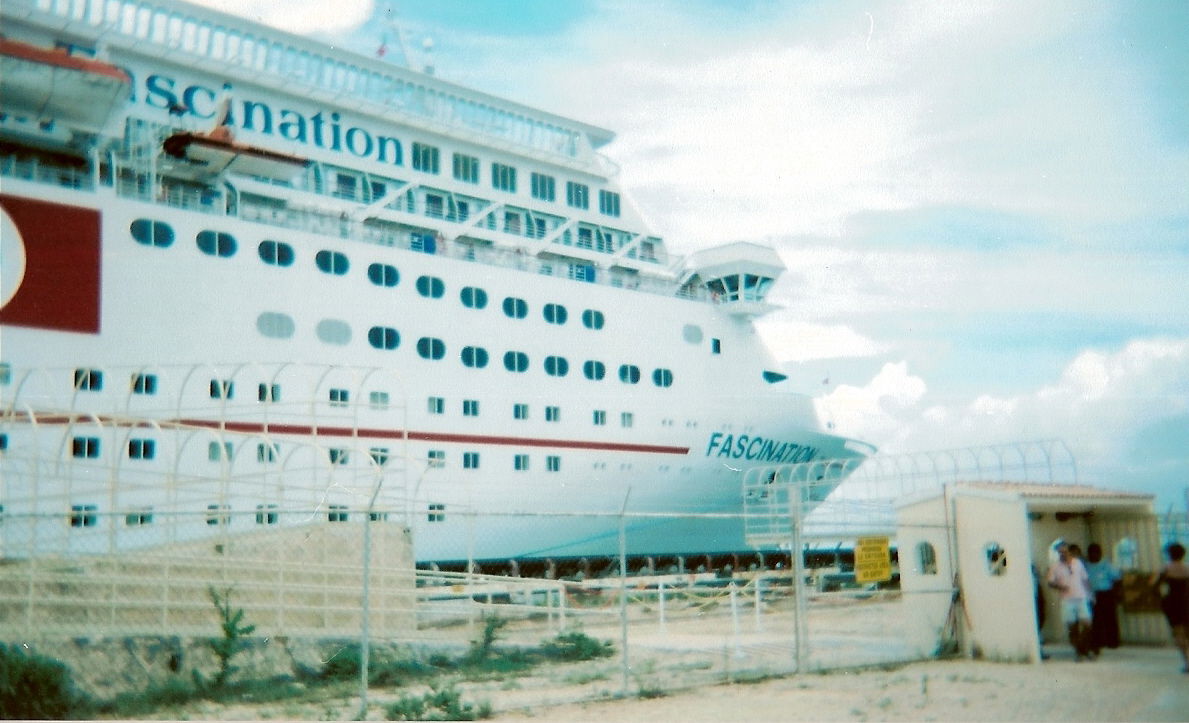The Tyler Chronicle Winter, 2022 Worldwide Edition
Taveling Texas Big Boy Meets Chronicle Publisher, Bobby D. Moore Marshall, Texas... From Archive, 11-11-2019 *It was a date with destiny, this meeting between Tyler Chronicle publisher, Bobby D. Moore and the legendary steam locomotive affectionately known as “Big Boy”. Moore traveled about 60 miles to keep the rendezvous, but many of the thousand or more others who kept the date drove hundreds. A light, cold rain was blowing in from the north by the time we reached the rail siding in Marshall. Puddles of muddy water were collecting in shallow depressions beside the tracks and patrolmen were hard pressed to control the influx of traffic. Parking space was not easy to find so we walked in the rain, new shoes, video cameras and all, the final several hundred yards. We knew exactly what camera angles we wanted for the shots, but getting them was all but impossible. Many of the spectators had brought umbrellas which made it even more difficult. They clustered around the million plus pounds of hot, breathing iron like baby chicks around a mother hen. They wanted to be intimately close, to touch, to smell and to feel the beast. Their attitude was that of awed respect and appreciation. Many of them seemed to understand, instinctively perhaps, the vital role that steam locomotives played in the history of our country. For it is true that the America we have known and loved was built on shining rails of steel. An unexpectedly high percentage of them expressed concern that many younger Americans do not understand and share that appreciation. The spectators varied in age from babes in arms to octagenarians in wheel chairs, young and old, rich and poor, city slickers and country bumpkins, busloads of students, to down and out hoboes. They were all there, drawn by a common thread; the lore and mystery of steam. It is easy to understand how the operators of steam locomotives (the brave engineers) became bigger than life characters. They assumed an identity above and beyond common mortals; they became a living flesh and blood extension of the locomotive itself.

(stock photo) Union Pacific's "Big Boy" steam locomotive was in Marshall, Texas on November 11, 2019 where hundreds gathered to experience this once in a lifetime opportunity. The enormous locomotive which weighs 1.2 million pounds is one of 25 built by the Alcoa Locomotive Works in New York in the 1940's and is the only remaining engine of its kind still in operation according to Union Pacific.

(photo courtesy Union Pacific) If you were an engineer or fireman inside the cab of "Big Boy", this is part of what you would see; a bewildering maze of valves, levers gages and other controls, all necessary for the successful operation of this enormous locomotive. The throttle (which serves the same purpose as the automobile accelerator) is on the right. Can you pick it out?
___________________________________
 Remember When? Remember When?
Texas Ports; Gateways to the World! Numerous cruise lines have ships which depart Galveston and other Texas ports on a regular basis. And if you haven't taken a trip on one of these luxury liners, you owe it to yourself to give it a try! The cost can be less than you might expect, and if you enjoy travel in comfortable surroundings, with excellent food and good company, you can't lose with a cruise.
Consider food, for example. Just for fun we asked what it takes to supply a typical week-long cruise on Royal Caribbean's Freedom of the Seas, the largest ship afloat. Here's what is consumed every 7 days:
234,000 appetizers; 105,000 meals and 300,680 desserts
20,000 lbs. of beef, including 69,000 steaks
12,000 lbs. of chicken
4,000 lbs. of seafood; 2,500 lbs. of salmon and 1,400 lbs. of lobster
65,000 lbs. of fresh vegetables and 35,000 lbs. of fresh fruits
5,800 lbs. of cheese
28,000 fresh eggs
18,000 slices of pizza
8,000 gallons of ice cream
1,500 lbs. of coffee and 1,500 gallons of milk
11,500 cans of soda; 19,200 bottles and cans of beer and 2,900 bottles of wine
 The Ghosts of Goliad
You cannot walk the corridors of Presidio La Bahia alone. The ghosts of Fannin's dead Texans walk with you. They whisper in the night, persistently demanding that you listen to the story they have to tell. Listen closely and you will hear the clash of armor, the shouting and shooting of battle and the cries of the dying... And the Dead. Fannin's soldiers have a story that must be told. Will you listen?
By 1835 American colonists in Texas had become frustrated enough with Mexican rule to fight a revolution.
On October 9, 1835, Captain George Coillinsworth led a group of angry Texans in an attack on the Mexican garrison stationed at Presidio La Bahia. They successfully took the fort and about two months later the first Declaration of Texas Independence from Mexico was signed at the fort near Goliad.
Goliad and the presidio are perhaps best remembered however, for what was probably the most infamous event of the Texas Revolution. In February, 1836, Colonel James Fannin of the Texas Army assumed command of the fort. But after the fall of the Alamo, Fannin and his soldiers were ordered by Sam Houston to retreat to Victoria.
The evacuation of the fort began March 19, but Fannin encountered Mexican General Jose' Urrea after about nine miles of travel. Fannin and his men were outnumbered and without provisions (even water). The battle of Coleto Creek resulted in Fannin's surrender with the agreement that he and his men would be held as prisoners of war. They were marched back to the fort and held in the chapel.
Although it is generally agreed that Urrea's intentions were to honor the terms of the surrender, Santa Anna ordered Fannin and his men to be executed. On Palm Sunday, March 27, the Texans were marched outside the presidio "for exercise". The story goes that Fannin paid his executioner not to shoot him in the face.
When the killing was done, Santa Anna's troops dumped the bodies of 342 dead and dying Texans into bonfires that burned long into the night.
The Goliad Massacre aroused sympathy and support for Texas from the United States, and "Remember Goliad" became a battle cry in the Texas War for Independence.
A memorial shaft near the presidio stands over the burial site of those killed in the massacre and about 10 miles northeast, Fannin Battleground State Historical Park marks the site of the Battle of Coleto Creek. (Tyler's "Camp Fannin" was named after Colonel James Fannin.)
Go to Goliad.
You'll like it, and you may learn a little about Texas history in the process. One thing is certain, you will come away from the old Mission Espiritu Santo and the fort (La Bahia) with a deeper sense of understanding and respect for the Texans who fought and died to make Texas an independent republic.
Goliad State Historical Park is a must-see. The central feature of the park is the Mission Espiritu Santo. this Spanish mission existed as an active mission for over 110 years (longer than any other in Texas).It was later used as a Protestant college, but was a shambles when the land was deeded to the state in 1932. The mission was carefully restored using authentic materials and methods by the Civilian Conservation Corps.
Mission tours are $2 per person; money well spent. A map will guide you through the ruins of the original structures along the banks of the San Antonio River.
Two camping areas are featured. One area caters to group campers with spacious sites and a dining hall. The other features RV hookups in addition to primitive riverside camping and picnicking. Both areas are along the meandering and steep banks of the San Antonio River and are heavily wooded. Screened shelters complete with overhead fans and lighting are available for rent. There's a nice swimming pool available too.
Here's a part of what's in or near Goliad: Presidio La Bahia, the Fannin Memorial, Fannin Battleground, ruins of the Mission Rosario, the town of Goliad itself, Goliad State Historical Park and Mission Espiritu Santo.
Fannin; Texas Hero, or Incompetent Leader?
BACKGROUND--- James Walker Fannin Jr. (1804-1836)was the illigitimate son of Er Isham Fannin of Georgia. Fannin was adopted by his maternal grandfather, James W. Walker and was reared on a plantation near Marion.
He entered the United States Military Academy at West Point under the name of James Walker, but withdrew after disagreements with classmates. In 1834 he moved to Texas with his wife and two daughters and settled at Velasco. There he operated a small plantation and bought and sold slaves.
In 1835, Fannin became a supporter of the Texas Revolution and an active member of the volunteer army for the revolution. he was commissioned as a colonel in the regular army of Texas by Sam Houston in 1836.
After an ill-fated plan to invade Matamoros, Mexico, Fannin withdrew to the Presidio La Bahia (Fort by the Bay) near Goliad. The presidio was strengthened to resist an expected attack by Mexican General Jose' Urrea.
DEFECTS AS A COMMANDER--- Fannin was accustomed to the discipline of a regular army and adapted poorly to being head of a group of volunteers; he dispised the idea of electing officers and was bothered by the absence of a clearly defined chain of command in his forces. His arrogance and overriding ambition served to earn him the contempt of many of those under his command. In the final weeks before the massacre at Goliad, Fannin repeatedly requested to be relieved of his command.
Today most historians concur that Fannin made many serious mistakes as a commander, ultimately resulting in his own death and that of 342 others fighting for the Texas cause at Goliad. But despite his indecisiveness, and obviously poor military judgement, he held out bravely until the end.
Fannin, Texas
As you might guess, the town located on U.S. Highway 59 about ten miles from Goliad is named for the controversial commander, James W. Fannin. The original settlement on Perdido Creek near the site of Fannin's defeat at the Battle of Coleto was established before 1852. A post office was established there in 1852 and was called Fannin's Defeat.
The town's name had been changed to "Perdido" by the time the second post office opened in 1873. By that time prosperity of a sort had come to the tiny community, a general store was in operation, a combination steam gin and gristmill was built as cotton became a local crop and a school and church wee constructed. Daily stages to Goliad and Victoria served the fifty residents in 1884.
Now comes the railroad. In 1889 the Gulf, Western Texas and Pacific Railway was routed a mile to the south of the settlement. The depot was called "Fannin", and the town moved to the railhead. As was often the case, the railroad brought prosperity and the town's population quickly grew.
By the early 1900's more than 300 residents populated Fannin, which by now had a cotton gin, a flour mill, two saloons, a hotel, a dance hall, a jail, and a blacksmith shop... as well as two houses of ill repute.
But trouble was on the way. In 1911, a feud between two locals resulted in gunplay at one of the town's saloons and a stray bullet just happened to strike a kerosene cookstove. The resulting conflagration destroyed most of the town. By 1933 the population had declined to about 100. The Fannin school closed in 1944 and the gin was torn down in the early 40's.
The railhead cattle pens were removed when ranchers began shipping cattle by truck, and the hotel, which had operated continuously from 1880 to 1950 closed it's doors. In 1990 Fannin had about 90 residents if you counted stray dogs and roosters!
Fannin Battleground State Historic Site
It's a mile south of U.S. Hwy. 59 at Fannin, in eastern Goliad County and marks the location of the Battle of Coleto between Texas Colonel Fannin and Mexican General Urrea during the Texas Revolution in 1836.
The battlefield was marked originally by a pile of rocks placed by William L. Hunter, one of Fannin's men who survived the battle and the resulting massacre at Goliad. In 1891 the pile of rocks was replaced by a massive iron screw from a cotton gin.
In 1914, the state constructed a rock wall around the area and erected a monument. In 1965 the thirteen acre park was placed under the care of the Texas Parks and Wildlife Dept. The iron screw still marks the entrance to the park and small museum.
Where Are the Heroes?
Where are the heroes in this story of Fannin and his men? There may not be any. does a man become a hero because he exercises poor judgement in a wartime situation which results in the murder of over 300 men?
There may be heroes in war, but war itself is ugly and in general, not a heroic undertaking. The Texas War for Independence from Mexico was no exception.
The Texans at Goliad were not, for the most part, professional soldiers. They were not recruits. They were a mixed bag of undisciplined volunteers whose motives probably varied widely.
Their leadership, in the person of Fannin, was inadequate, as Fannin himself admitted. If Fannin had followed the orders of Texas General Sam Houston, he would not have been "slouching" away from Goliad to be overtaken by Mexican General Urrea. In fact, he would not have been at the persidio at all.
The decision to establish himself at Goliad was Fannin's own. The Texas government at that time was rife with confusion and intrigue. Orders were often contradicted or ignored.
The Mexican army under general Urrea, although better disciplined than Fannin's, was itself, quite a hodgepodge. The Mexican "soldiers" who actually carried out the execution of Fannin and his men were Yucatan Indians.
But regardless of how heroic we may or may not consider Fannin, one cannot visit the persidio at Goliad without feeling the spirits of the men who died there. One thing is certain, a very great price was paid to secure the freedom of the Republic of Texas.
We live in a sea of myths. They seem to be a necessary part of human existence. if we dispel the myths of Goliad, others will come to take their place. so, let us not be myth-busters. But let us recognize that a great price was paid for our freedom and must be continually... repaid.

|